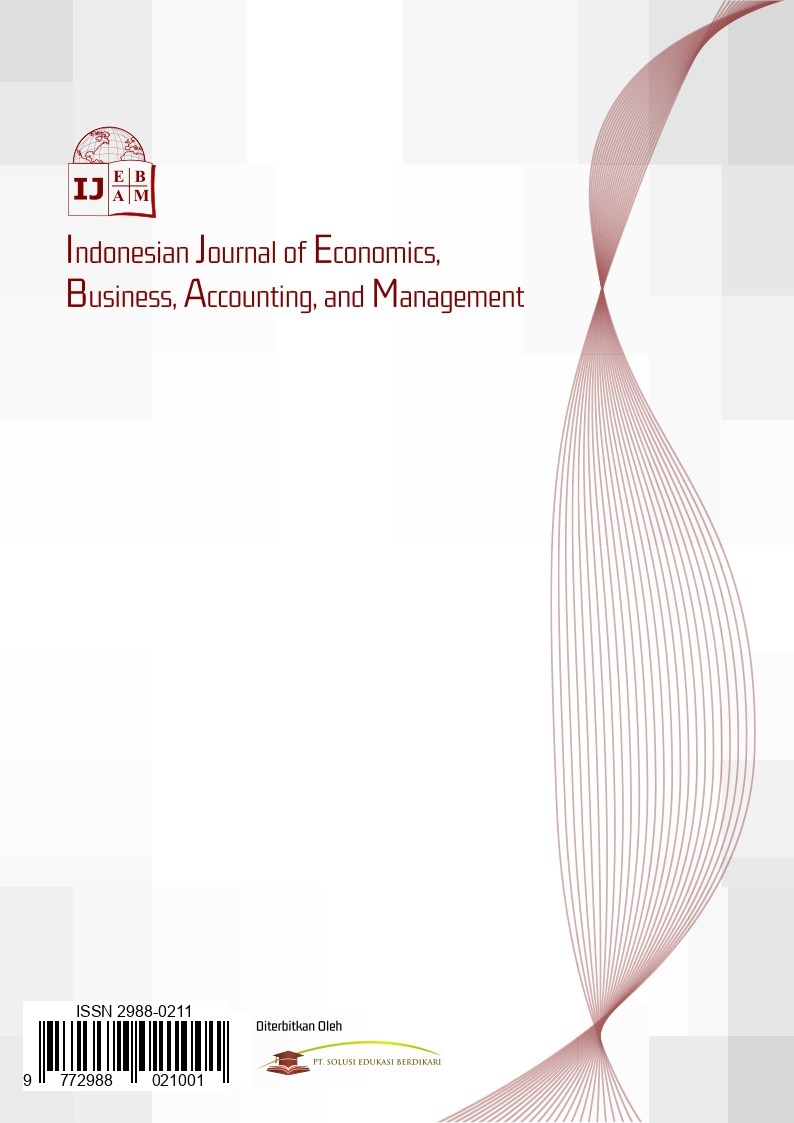Abstrak
This study aims to examine the effect of the environment on green trust, green satisfaction, green perceived quality on Wardah cosmetics consumers in the Special Region of Yogyakarta. In this study, the population used is both men and women in the Special Region of Yogyakarta who will or have used Wardah cosmetic products. The number of samples is 180 respondents with criteria aged 17-60 years. The analysis technique used in this study uses Structural Equation Modeling (SEM) which is processed with AMOS 22 and data collection using a purposive sampling technique. The results of this study indicate a positive influence from the influence of environmental friendliness on green trust, green satisfaction, and green perceived quality. In addition, this study also shows the positive influence of green satisfaction and green perceived quality on green trust.
Referensi
Aaker, D.A. (2010) Building Strong Brands. London: Simon and Schuster.
Ahmad, F., Lapian, J. and Soegoto, A.S. (2016) “Analisis Green Product dan Green Marketing Strategy terhadap Keputusan Pembelian Produk The Body Shop di Manado Town Square,” Jurnal EMBA : Jurnal Riset Ekonomi, Manajemen, Bisnis dan Akuntansi, 4(1), pp. 33–44. Available at: https://www.neliti.com/publications/2873/analisis-green-product-dan-green-marketing-strategy-terhadap-keputusan-pembelian#cite.
Anuwichanont, J. and Mechinda, P. (2009) “The Impact Of Perceived Value On Spa Loyalty And Its Moderating Effect Of Destination Equity,” Journal of Business & Economics Research (JBER), 7(12). Available at: https://doi.org/10.19030/jber.v7i12.2368.
Brucks, M., Zeithaml, V.A. and Naylor, G. (2000) “Price and brand name as indicators of quality dimensions for consumer durables,” Journal of the Academy of Marketing Science, 28(3), pp. 359–374. Available at: https://doi.org/10.1177/0092070300283005.
Chang, S.-C., Chou, P.-Y. and Lo, W.-C. (2013) “Evaluation of satisfaction and repurchase intention in online food group-buying, using Taiwan as an example,” British Food Journal, 116(1), pp. 44–61. Available at: https://doi.org/10.1108/BFJ-03-2012-0058.
Chen, Y.-S. (2010) “The Drivers of Green Brand Equity: Green Brand Image, Green Satisfaction, and Green Trust,” Journal of Business Ethics, 93(2), pp. 307–319. Available at: https://doi.org/10.1007/s10551-009-0223-9.
Chen, Y.-S., Lin, C.-Y. and Weng, C.-S. (2015) “The Influence of Environmental Friendliness on Green Trust: The Mediation Effects of Green Satisfaction and Green Perceived Quality,” Sustainability, 7(8), pp. 10135–10152. Available at: https://doi.org/10.3390/su70810135.
Chen, Y. and Chang, C. (2012) “Enhance green purchase intentions: The roles of green perceived value, green perceived risk, and green trust,” Management Decision, 50(3), pp. 502–520. Available at: https://doi.org/10.1108/00251741211216250.
Chen, Y. and Chang, C. (2013) “Towards green trust: The influences of green perceived quality, green perceived risk, and green satisfaction,” Management Decision, 51(1), pp. 63–82. Available at: https://doi.org/10.1108/00251741311291319.
Dangelico, R.M. and Vocalelli, D. (2017) “‘Green Marketing’: An analysis of definitions, strategy steps, and tools through a systematic review of the literature,” Journal of Cleaner Production, 165, pp. 1263–1279. Available at: https://doi.org/10.1016/j.jclepro.2017.07.184.
Ferdinand, A. (2005) Structural Equation Modeling Dalam Penelitian Manajemen: Aplikasi Model-Model Rumit Dalam Penelitian Untuk Tesis Magister & Disertasi Doktor. 3rd ed. Semarang: Badan Penerbit Universitas Diponegoro.
Ghozali, I. and Fuad (2005) Structural Equation Modeling: Teori Konsep dan Aplikasi dengan Program Lisrael 9.10. Semarang: Badan Penerbit Universitas Diponegoro.
Hair Jr., J.F. et al. (2019) Multivariate Data Analysis. 8th ed. New York: Cengage Learning.
Hanifah, A.D., Arifin, Z. and Hidayat, K. (2016) “PENGARUH BAURAN PEMASARAN BERWAWASAN GREEN MARKETING TERHADAP KEPUTUSAN PEMBELIAN (Survei pada Pembeli yang Menghuni Perumahan Ijen Nirwana Malang),” Jurnal Administrasi Bisnis (JAB), 32(2), pp. 23–32. Available at: http://download.garuda.kemdikbud.go.id/article.php?article=405206&val=6468&title=PENGARUH BAURAN PEMASARAN BERWAWASAN GREEN MARKETING TERHADAP KEPUTUSAN PEMBELIAN Survei pada Pembeli yang Menghuni Perumahan Ijen Nirwana Malang.
Kang, S. and Hur, W.-M. (2012) “Investigating the Antecedents of Green Brand Equity: A Sustainable Development Perspective,” Corporate Social Responsibility and Environmental Management, 19(5), pp. 306–316. Available at: https://doi.org/10.1002/csr.281.
Kotler, P. and Keller, K.L. (2016) Marketing Management. 15th ed. Upper Saddle River, NJ: Pearson (Always learning).
Kumar, Vinod, Rahman, Zillur and Kazmi, A.A. (2013) “Sustainability Marketing Strategy: An Analysis of Recent Literature,” Global Business Review, 14(4), pp. 601–625. Available at: https://doi.org/10.1177/0972150913501598.
Murga-Menoyo, M.Á. (2014) “Learning for a Sustainable Economy: Teaching of Green Competencies in the University,” Sustainability, 6(5), pp. 2974–2992. Available at: https://doi.org/10.3390/su6052974.
Pratama, M.A. (2014) “Pengaruh Green Perceived Value, Green Perceived Risk Dan Green Trust Terhadap Green Purchase Intention Lampu Philips LED di Surabaya,” Calyptra: Jurnal Ilmiah Mahasiswa Universitas Surabaya, 3(1), pp. 1–20. Available at: http://download.garuda.kemdikbud.go.id/article.php?article=832860&val=5455&title=PENGARUH GREEN PERCEIVED VALUE GREEN PERCEIVED RISK DAN GREEN TRUST TERHADAP GREEN PURCHASE INTENTION LAMPU PHILIPS LED DI SURABAYA.
Putra, K.D.S. and Rastini, N.M. (2017) “PENGARUH GREEN PERCEIVED VALUE DAN GREEN PERCEIVED QUALITY TERHADAP GREEN SATISFACTION DAN GREEN TRUST,” E-Jurnal Manajemen Unud, 6(5), pp. 2789–2816. Available at: http://download.garuda.kemdikbud.go.id/article.php?article=1370519&val=989&title=PENGARUH GREEN PERCEIVED VALUE DAN GREEN PERCEIVED QUALITY TERHADAP GREEN SATISFACTION DAN GREEN TRUST.
Rahmawati, E.K. et al. (2024) “Islamic psychology in leadership practices: a case study of wardah cosmetics,” in Proceeding of The 4th International Students Conference on Islamic Psychology 2024. Yogyakarta: Universitas Islam Indonesia, pp. 43–49. Available at: https://conference.uii.ac.id/iscip/paper/view/108/8.
Ranaweera, C. and Prabhu, J. (2003) “The influence of satisfaction, trust and switching barriers on customer retention in a continuous purchasing setting,” International Journal of Service Industry Management, 14(4), pp. 374–395. Available at: https://doi.org/10.1108/09564230310489231.
Ritter, Á.M. et al. (2015) “Motivations for promoting the consumption of green products in an emerging country: exploring attitudes of Brazilian consumers,” Journal of Cleaner Production, 106, pp. 507–520. Available at: https://doi.org/10.1016/j.jclepro.2014.11.066.
Suara Muhammadiyah (2025) Wardah Dinobatkan sebagai Merek Kosmetik Paling Ramah Muslim di Dunia, Suara Muhammadiyah. Available at: https://www.suaramuhammadiyah.id/read/wardah-dinobatkan-sebagai-merek-kosmetik-paling-ramah-muslim-di-dunia (Accessed: November 22, 2025).
Sugiyono (2016) Metode Penelitian: Kuantitatif, Kualitatif dan R&D. Bandung: Penerbit Alfabeta.
Sweeney, J.C., Soutar, G.N. and Johnson, L.W. (1999) “The role of perceived risk in the quality-value relationship: A study in a retail environment,” Journal of Retailing, 75(1), pp. 77–105. Available at: https://doi.org/10.1016/S0022-4359(99)80005-0.
Walter, A., Mueller, T.A. and Helfert, G. (2000) “The Impact of Satisfaction , Trust , and Relationship Value on Commitment : Theoretical Considerations and Empirical Results,” in Proceedings of the 16th IMP Conference. Bath, UK: IMP Group. Available at: https://api.semanticscholar.org/CorpusID:8457417.
Zhuang, W. et al. (2010) “The Impact of Perceived Value on Behavior Intention: An Empirical Study,” Journal of Global Business Management, 6(2), pp. 1–7. Available at: https://www.proquest.com/openview/4d151382c10411a5702113963d53a7b6/1.pdf?pq-origsite=gscholar&cbl=406316.

Artikel ini berlisensiCreative Commons Attribution-ShareAlike 4.0 International License.
Hak Cipta (c) 2025 Shafa Fauzan

